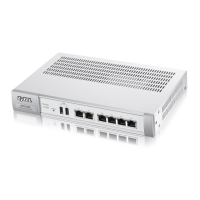Chapter 9 Interfaces
NXC Series User’s Guide
175
On the other hand, some communication channels, such as Ethernet over ATM, might not be able to
handle large data packets.
DHCP Settings
Dynamic Host Configuration Protocol (DHCP, RFC 2131, RFC 2132) provides a way to automatically set
up and maintain IP addresses, subnet masks, gateways, and some network information (such as the IP
addresses of DNS servers) on computers in the network. This reduces the amount of manual
configuration you have to do and usually uses available IP addresses more efficiently.
In DHCP, every network has at least one DHCP server. When a computer (a DHCP client) joins the
network, it submits a DHCP request. The DHCP servers get the request; assign an IP address; and provide
the IP address, subnet mask, gateway, and available network information to the DHCP client. When the
DHCP client leaves the network, the DHCP servers can assign its IP address to another DHCP client.
In the NXC, some interfaces can provide DHCP services to the network. In this case, the interface can
be a DHCP relay or a DHCP server.
As a DHCP relay, the interface routes DHCP requests to DHCP servers on different networks. You can
specify more than one DHCP server. If you do, the interface routes DHCP requests to all of them. It is
possible for an interface to be a DHCP relay and a DHCP client simultaneously.
As a DHCP server, the interface provides the following information to DHCP clients.
• IP address - If the DHCP client’s MAC address is in the NXC’s static DHCP table, the interface assigns
the corresponding IP address. If not, the interface assigns IP addresses from a pool, defined by the
starting address of the pool and the pool size.
The NXC cannot assign the first address (network address) or the last address (broadcast address) in
the subnet defined by the interface’s IP address and subnet mask. For example, in the first entry, if the
subnet mask is 255.255.255.0, the NXC cannot assign 50.50.50.0 or 50.50.50.255. If the subnet mask is
255.255.0.0, the NXC cannot assign 50.50.0.0 or 50.50.255.255. Otherwise, it can assign every IP address
in the range, except the interface’s IP address.
If you do not specify the starting address or the pool size, the interface the maximum range of IP
addresses allowed by the interface’s IP address and subnet mask. For example, if the interface’s IP
address is 9.9.9.1 and subnet mask is 255.255.255.0, the starting IP address in the pool is 9.9.9.2, and the
pool size is 253.
• Subnet mask - The interface provides the same subnet mask you specify for the interface.
• Gateway - The interface provides the same gateway you specify for the interface.
• DNS servers - The interface provides IP addresses for up to three DNS servers that provide DNS services
for DHCP clients. You can specify each IP address manually (for example, a company’s own DNS
server), or you can refer to DNS servers that other interfaces received from DHCP servers (for example,
a DNS server at an ISP). These other interfaces have to be DHCP clients.
It is not possible for an interface to be the DHCP server and a DHCP client simultaneously.
Table 74 Example: Assigning IP Addresses from a Pool
START IP ADDRESS POOL SIZE RANGE OF ASSIGNED IP ADDRESS
50.50.50.33 5 50.50.50.33 - 50.50.50.37
75.75.75.1 200 75.75.75.1 - 75.75.75.200
99.99.1.1 1023 99.99.1.1 - 99.99.4.255
120.120.120.100 100 120.120.120.100 - 120.120.120.199

